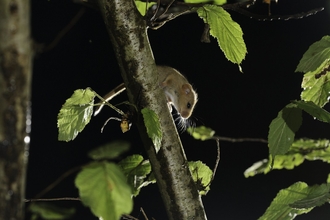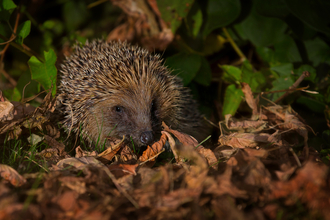The hedgehog is famously known for hibernating in the winter, but how much do you know about this, and which other wildlife do it too?
Hibernation allows our native wildlife to survive long periods of cold by reducing the bodily functions that use up lots of energy, to make it go further. Heart rate, body temperature, metabolic and respiration rates all decrease. So as long as they have enough in reserve to wake their bodies up again in the spring, it should be a dream.
Sadly, many of our hibernating species do not survive the winter, usually because they didn’t have enough fat and energy reserves before going into hibernation. Their survival also depends on not being disturbed as the extreme cold, lack of food and energy required to get back to sleep can be overwhelming.
Hedgehogs are nocturnal animals and love to scurry around after dark. They can cover around 2km each night for food and they aren't too fussy where to roam to either. Grasslands, woodlands and hedgerows are perfect habitats, but they have adapted to living around our gardens, communal parks and even quiet cemeteries. Hedgehogs start to hibernate when the weather turns colder around November, and when all hoglets have left their nest. The little ones of second litters are in a race against time to put on enough weight to survive their first winter on their own, which means they are often the last to go into hibernation, but also the least likely to survive the whole winter. Despite their prickly exterior hedgehogs don’t have adequate insulation to be out during the winter and their natural food source of insects and grubs will have long since gone. So, by November, they take advantage of the abundance of fallen autumn leaves and log piles, which make an attractive and safe winter retreat. However, this is also a time when us humans tidy up our gardens and risk it all with bonfires.
Whilst many of us try to lose a few pounds before the Christmas excesses, hedgehogs actively seek out and eat as much as possible. Ideally, they need to fatten up to at least 600g in weight. It’s not surprising you hear so many pleas to look out for underweight hedgehogs and put out supplementary food and water. It could literally be a life saver. Hedgehogs shouldn't be fed bread and milk though, so when meals are left out for them, it is best to use approved hedgehog friendly dry food, or kitten food (as long as it doesn't contain fish or gravy).
Another expert in hibernation, and just pipping the hedgehog on the cuteness scale, is the dormouse. Following the summer months of feasting on nuts, berries and insects to build up their fat reserves, the dormouse is the only rodent to enter full hibernation for the winter. You would think that as they tend to sleep much of the time that they wouldn’t need to hibernate, but they actually spend over half of the year in hibernation. Dormice really need to double their weight, to approximately 40g in order to keep their bodies functioning and insulated over winter ready for spring.
The hedgerows and mid tree canopies are where dormice prefer to live, so we should endeavour to keep these habitats as natural as possible. Dormice build their nests from grasses and soft tree bark, which is tightly woven into a ball-shaped cup in which they hibernate, protected from the world around them. Heavy handed machinery used on hedgerows is all too common in destroying dormice nest sites. Life is hard in winter for wildlife, so let’s go easy on them and give the trimming a rest.
Our native bats also hibernate partially over the main winter months in specific hibernation roosts, especially as their main food source of insects are very few and far between at this time of year. However, they also dip in and out of the involuntary state of ‘torpor’. It’s effectively a deep state of rest with similar body changes as hibernation but happens when the environmental conditions dictate, rather than for an a specific prolonged season. Any hibernating mammals can sometimes awaken on warmer days to find additional food, but bats do so much more frequently. Bats have extended periods of torpor prior to going into hibernation, so it really depends on the climate and if they have been successful in finding a suitable roosting site. Hollow tree trunks, caves and crevices in old buildings help keep them safe, but it is possible that you may see a bat flying around in winter on milder days.
Other mammals that snooze in a state of torpor are badgers and squirrels. It’s nature’s way of protecting the species when the weather is poor, and given that we have our fair share of bleak weather, that’s a great help. Badgers curl up in their family setts and squirrels temporarily hunker down in dreys conserving energy. On warmer days they will awaken to replenish their fat reserves by hunting for alternative food or, in the case of squirrels, trying to remember where they have hidden their stash of nuts and acorns!
Most amphibians: the frogs, toads and newts overwinter in quiet areas of vegetation, leaf piles, compost heaps, dead wood and even in loose soil as they bury themselves below the surface level and away from the temperature extremes. However, they don't tend to hibernate for the whole winter and may come out during spells of mild weather for a spot of foraging. It’s not uncommon to still see them active in your garden during milder spells, even if you don’t have a pond. Similarly, log piles, leaves and compost provide hibernating sites for our reptiles such as common lizards, grass snakes, adders and slow worms. These species can be greatly impacted by human disturbance, as it takes a lot of effort and valuable energy to recover and return back to hibernation...and can greatly reduces their survival prospects.
With our climate being a significant factor in the torpor and hibernation patterns of our native wildlife, it does beg the question ‘will climate change be better or worse for our hibernators? The answer varies between species, but those mammals like dormice, which depend on there being a plentiful supply of nuts and berries will be the first to suffer if changing climatic conditions impact the reliability of nut producing trees when they most need it. Only time will tell, so for now, we can all do out bit to protect our hibernating animals by providing them with ample safe places to sleep and to minimise the risk of disturbing them in winter.



